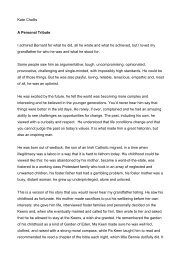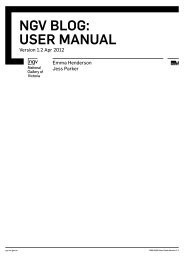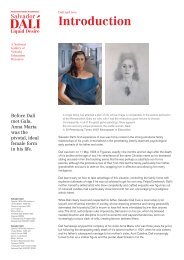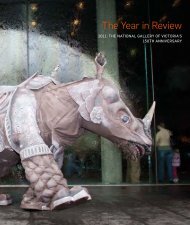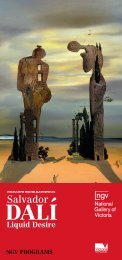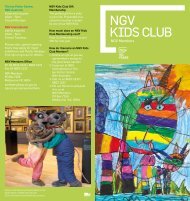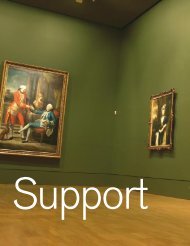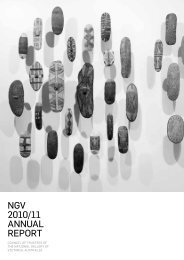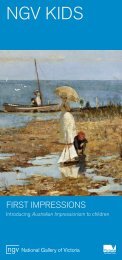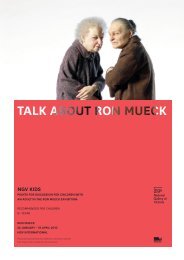Edvard Munch - Education Guide - National Gallery of Victoria
Edvard Munch - Education Guide - National Gallery of Victoria
Edvard Munch - Education Guide - National Gallery of Victoria
You also want an ePaper? Increase the reach of your titles
YUMPU automatically turns print PDFs into web optimized ePapers that Google loves.
EDUCATION RESOURCE
introduction<br />
Anxiety (Angst) 1894. Oil on canvas. <strong>Munch</strong>-museet, Oslo
<strong>Edvard</strong> <strong>Munch</strong>: The Frieze <strong>of</strong> Life<br />
We want more than a mere photograph <strong>of</strong> nature.<br />
We do not want to paint pretty pictures to be hung on<br />
drawing-room walls. We want to create, or at least<br />
lay the foundations <strong>of</strong>, an art that gives something<br />
to humanity. An art that arrests and engages. An art<br />
created <strong>of</strong> one’s innermost heart.<br />
<strong>Edvard</strong> <strong>Munch</strong><br />
<strong>Edvard</strong> <strong>Munch</strong>, Norway’s greatest painter, began his long career<br />
in 1880 at the age <strong>of</strong> seventeen. He brought art and life together<br />
by communicating his own personal experience passionately. His<br />
intense expression <strong>of</strong> raw human emotion and his exploration <strong>of</strong><br />
psychological states have a universal appeal which still speaks to<br />
us today.<br />
The scream, <strong>Munch</strong>’s iconic work, has come to symbolise the<br />
angst <strong>of</strong> modern man in today’s frenetic society and, like the Mona<br />
Lisa, is one <strong>of</strong> the most frequently reproduced images in the world.<br />
<strong>Munch</strong> worked in a variety <strong>of</strong> media, repeatedly exploring the same<br />
themes in painting, drawing, etching, lithography, photography and<br />
woodcuts.<br />
Potent imagery and dramatic use <strong>of</strong> heightened colour, both radical<br />
in their time, combined with his innovative studio techniques,<br />
have secured <strong>Munch</strong>’s reputation as one <strong>of</strong> the most revered and<br />
influential artists <strong>of</strong> the twentieth century.<br />
Disease and madness and death were the black angels<br />
standing over my cradle.<br />
<strong>Edvard</strong> <strong>Munch</strong><br />
<strong>Munch</strong> was born in 1863 into a poor but well educated, middleclass<br />
Norwegian family. His father, Christian <strong>Munch</strong>, an intensely<br />
conservative and religious man, worked as a doctor with the army<br />
whilst his mother, Laura, looked after their children.<br />
<strong>Munch</strong>’s early life was scarred by a series <strong>of</strong> traumatic events which<br />
pr<strong>of</strong>oundly shaped the development <strong>of</strong> his work. Apart from being<br />
plagued by illness himself, his suffering was compounded when his<br />
mother died <strong>of</strong> tuberculosis (he was then five years old), causing his<br />
father to develop a religious fervour which brought him to the verge<br />
<strong>of</strong> insanity. Nine years later, <strong>Munch</strong> lost his older sister Sophie, also<br />
to tuberculosis. His brother, Andreas, also died young in 1895.<br />
Interestingly, <strong>Munch</strong> conceded as an adult that the depression<br />
caused by this very pain and suffering was the driving force behind<br />
his creative life, saying, ‘I would not cast <strong>of</strong>f my illness for there is<br />
much in my art that I owe to it’.<br />
In 1880, <strong>Munch</strong> entered the School <strong>of</strong> Design in Kristiania (now<br />
called Oslo) and studied drawing under one <strong>of</strong> the leading sculptors<br />
<strong>of</strong> the day. His early works reflect the influence <strong>of</strong> Christian Krohg<br />
who trained him in the schools <strong>of</strong> Naturalism and Plein Air, and<br />
who became a great advocate <strong>of</strong> <strong>Munch</strong>’s work when initially it was<br />
savagely rejected by Norwegian society.<br />
By the mid 1880s, <strong>Munch</strong> had become part <strong>of</strong> an anarchistic group<br />
<strong>of</strong> artists and writers led by the philosopher Hans Jaeger, whose<br />
book detailing his sexual exploits and Bohemian lifestyle was<br />
considered so shocking in the prevailing puritanical society that<br />
he was sent to prison. Jaeger’s belief that art should be inspired<br />
by one’s personal experience and inner life guided <strong>Munch</strong> towards<br />
expressing the emotional turmoil he was experiencing.<br />
At the age <strong>of</strong> twenty-two, <strong>Munch</strong> had a tumultuous affair with<br />
a married woman, Milly Thaulow, known in his diaries as ‘Mrs<br />
Heiberg’, the first great love <strong>of</strong> his life. His adulterous behaviour was<br />
so contrary to the strict moral upbringing enforced by his father that<br />
he was haunted by overwhelming feelings <strong>of</strong> guilt.<br />
<strong>Munch</strong>’s lucid and evocative writings are as expressive as his art,<br />
and about this time he started to write what later became known<br />
as his literary diaries, where he described love scenes, childhood<br />
tragedies and impressions <strong>of</strong> Kristiania café society.<br />
I began as an Impressionist but it was limited and I had<br />
to find another way <strong>of</strong> expressing the emotional turmoil<br />
I experienced during that Bohemian period <strong>of</strong> my life …<br />
‘The Sick Child’ was the first break from Impressionism<br />
– I was searching for expression.<br />
<strong>Edvard</strong> <strong>Munch</strong><br />
When <strong>Munch</strong>’s early works reflecting his intense personal pain,<br />
such as The sick child (exhibited under the title A study in 1886),<br />
were exhibited in Kristiania, the unashamedly raw application <strong>of</strong><br />
the paint and the ‘unfinished’ quality caused a storm <strong>of</strong> protests<br />
from the press and public. Despite this initial hostile response, his<br />
one-man exhibition in 1889, which was more optimistic in tone and<br />
featured a monumental portrait <strong>of</strong> Hans Jaeger, secured him the<br />
first <strong>of</strong> a series <strong>of</strong> state scholarships which allowed him to study in<br />
France for three years.<br />
At this time, <strong>Munch</strong> stayed in a house in Åsgårdstrand, a seaside<br />
retreat to which he returned almost every summer for twenty years<br />
and which was the setting for numerous paintings.<br />
Self-portrait on his trunk in his studio in 82 Lützowstrasse in Berlin 1902. Collodion silver photograph. <strong>Munch</strong>-museet, Oslo<br />
Death in the sickroom (Døden i sykevoerelset) 1896. Hand-coloured lithograph. <strong>Munch</strong>-museet, Oslo
Angst, Love, Death<br />
While studying in Paris and in Nice in the south <strong>of</strong> France,<br />
<strong>Munch</strong> was influenced by the Impressionists’ fascination<br />
with light and by the growing Symbolist movement which<br />
inspired his symbolic use <strong>of</strong> colour and simplification <strong>of</strong> form.<br />
He saw the work <strong>of</strong> Gauguin and van Gogh, whose Starry<br />
night he paid tribute to in his own painting <strong>of</strong> the same name<br />
thirty years later. These influences, together with the curving,<br />
sweeping lines <strong>of</strong> Art Nouveau, were rapidly melded into his<br />
highly individual style.<br />
<strong>Munch</strong>’s decision, at the age <strong>of</strong> seventeen, to become a painter<br />
was driven by the pr<strong>of</strong>ound emotional experiences <strong>of</strong> his childhood.<br />
<strong>Munch</strong> expressed the importance <strong>of</strong> communicating the<br />
emotional and psychological aspects <strong>of</strong> his experiences as early<br />
as 1888, when he was twenty-four:<br />
We want more than a mere photograph <strong>of</strong> nature …<br />
We want … an art created <strong>of</strong> one’s innermost heart.<br />
<strong>Edvard</strong> <strong>Munch</strong><br />
Just as Leonardo studied human anatomy and<br />
dissected corpses, so I try to dissect souls.<br />
<strong>Edvard</strong> <strong>Munch</strong><br />
<strong>Munch</strong>’s first exhibition in Berlin in 1892 caused a scandal<br />
mainly due to the very personal subject matter which was<br />
not considered acceptable, and it was closed after a week.<br />
The torrent <strong>of</strong> publicity which followed made <strong>Munch</strong> instantly<br />
famous and <strong>of</strong>fers <strong>of</strong> exhibitions flooded in. <strong>Munch</strong> stayed in<br />
Germany for the next three years, where his pioneering ideas<br />
flowered in the stimulating company <strong>of</strong> a radical group <strong>of</strong><br />
adventurous writers, critics, poets and artists.<br />
Led by the writer August Strindberg, who wrote<br />
psychological plays and prose, they met regularly at The<br />
Black Pig café in Berlin where they discussed Symbolism,<br />
psychology, eroticism and death. It was here that <strong>Munch</strong><br />
began his series <strong>of</strong> paintings known as The frieze <strong>of</strong> life, and<br />
to which he returned at the end <strong>of</strong> his life. These images,<br />
which in <strong>Munch</strong>’s words came from ‘the reverse side <strong>of</strong><br />
the eye’ and where colour was used emotively and not<br />
descriptively, were intended to be displayed together as a<br />
symbolic celebration <strong>of</strong> the ‘poetry <strong>of</strong> life, love and death’.<br />
In 1898 he began a turbulent relationship with Tulla Larsen,<br />
a wealthy, middle-class, Norwegian woman who became<br />
infatuated with him. The affair ended dramatically in 1902<br />
when, during an argument, he was wounded by a gunshot,<br />
damaging the middle finger <strong>of</strong> his left hand. <strong>Munch</strong> became<br />
obsessed with the injury which made it painful for him to hold<br />
his palette and was a constant reminder <strong>of</strong> the agony <strong>of</strong> the<br />
ill fated relationship. This traumatic incident, combined with<br />
excessive drinking and exhaustion, eventually caused him<br />
to suffer a nervous breakdown, and in 1908–09 he spent<br />
several months in a psychiatric clinic in Copenhagen.<br />
After his recovery he settled permanently in Norway, moving<br />
to an isolated estate in Kragerø on the southern coast. <strong>Munch</strong><br />
never fully abandoned his darker themes, returning to them<br />
throughout his life, but from this time onwards his work<br />
reflected a more peaceful chapter in his life. He concentrated<br />
on external subjects such as landscapes, portraits and figure<br />
studies which were s<strong>of</strong>t and lyrical compared with the intense,<br />
anguished works <strong>of</strong> previous years.<br />
<strong>Munch</strong>’s expressive brushwork and uninhibited colour<br />
pr<strong>of</strong>oundly influenced the German Expressionists, and in<br />
1913 he and Picasso were the only two foreign artists to<br />
be invited to exhibit at the Autumn Exhibition in Berlin, in<br />
appreciation <strong>of</strong> their importance to young German artists.<br />
In 1916, <strong>Munch</strong> bought the Ekely property at Skøyen near<br />
Oslo where he lived a simple, reclusive life surrounded by his<br />
paintings which he regarded as his children.<br />
During World War II, his art was labelled ‘degenerate’ by the<br />
Nazis and removed from German museums. He continued<br />
to work defiantly until his death at the age <strong>of</strong> eighty in 1944,<br />
when he left over 1000 paintings, 3000 drawings and watercolours,<br />
and 17,000 prints to the city <strong>of</strong> Oslo.<br />
Angst (Angst) 1896. Colour woodcut. <strong>Munch</strong>-museet, Oslo<br />
Drawing on his own experience, the themes <strong>of</strong> love and death<br />
became the recurring and interrelated subjects for his art. The<br />
emotional states <strong>of</strong> anxiety and melancholy, the complex aspects<br />
<strong>of</strong> sexual love – attraction, separation, jealousy – and the trauma<br />
<strong>of</strong> sickness and death were the themes that <strong>Munch</strong> returned to<br />
over and over. In 1892 he conceived <strong>of</strong> these works as a series.<br />
‘I placed them (the paintings) together and found that various<br />
paintings related to each other in terms <strong>of</strong> content. When they<br />
were hung together, suddenly a single musical note passed<br />
through them all. They became completely different from what<br />
they had been previously. A symphony resulted.’ (<strong>Munch</strong> in<br />
1933). This series became known as The frieze <strong>of</strong> life.<br />
The scream is <strong>Munch</strong>’s best known painting. Describing the<br />
experience which led to this image he wrote:<br />
I was walking along a path with two friends. The sun<br />
set. I felt a tinge <strong>of</strong> melancholy. Suddenly the sky<br />
became a bloody red.<br />
I stopped, leaned against the railing, dead tired [my<br />
friends looked at me and walked on] and I looked at the<br />
flaming clouds that hung like blood and a sword [over<br />
the fjord and city] over the blue-black fjord and city.<br />
My friends walked on. I stood there, trembling with<br />
fright. And I felt a loud, unending scream piercing<br />
nature.<br />
From Reinhold Heller, <strong>Munch</strong>. The Scream, New York, 1972
The dance <strong>of</strong> life (Livets dans) 1925–29<br />
oil on canvas. <strong>Munch</strong>-museet, Oslo<br />
<strong>Munch</strong>’s experience <strong>of</strong> pr<strong>of</strong>ound anxiety<br />
and emotional turmoil is given visual form in<br />
the waves <strong>of</strong> intense colour, distorting the<br />
natural world. The screaming figure is swept<br />
into and becomes part <strong>of</strong> the distorted<br />
world. In portraying his own personal<br />
experience, <strong>Munch</strong> found a language to<br />
communicate the overwhelming anxiety<br />
experienced by many people.<br />
A similar phenomenon is evoked in Anxiety,<br />
1894. In this case however the dark figures<br />
with their mask-like faces seem to be<br />
experiencing the sense <strong>of</strong> isolation and<br />
alienation that was to become increasingly<br />
an element <strong>of</strong> life in the modern urban<br />
environment. <strong>Munch</strong> reinterpreted the<br />
painted version <strong>of</strong> this image as a woodcut<br />
two years later. As a woodcut, the subject<br />
has an even greater rawness and starkness,<br />
and may suggest why <strong>Munch</strong> experimented<br />
with representing similar subjects in a<br />
variety <strong>of</strong> media.<br />
The themes <strong>of</strong> sickness and death reflect<br />
the experiences <strong>of</strong> <strong>Munch</strong>’s early life.<br />
‘Disease and madness and death’, he<br />
wrote, ‘were the black angels standing<br />
over my cradle’. In the lithograph Death<br />
in the sickroom, 1896, <strong>Munch</strong>’s family is<br />
gathered in the room, aware that <strong>Munch</strong>’s<br />
sister Sophie is dying. The weight <strong>of</strong> her<br />
loss is simply and powerfully portrayed by<br />
her absence in the painting: she is sitting<br />
in the chair and is the only one not visible<br />
to the viewer. The ongoing experience <strong>of</strong><br />
grief is conveyed by the fact that <strong>Munch</strong>’s<br />
family is shown at the age they were when<br />
the work was created, rather than at their<br />
age when Sophie died eight years earlier.<br />
<strong>Munch</strong>’s father stands before Sophie, his<br />
hands clasped in prayer. <strong>Munch</strong>’s aunt<br />
Karen gestures consolingly towards her. In<br />
the foreground group, <strong>Munch</strong>’s sister Laura<br />
sits with her head bowed; behind her, Inger,<br />
the third sister, stares out from a mask-like<br />
face. <strong>Munch</strong> himself stands immediately<br />
behind her, and their brother Andreas turns<br />
blankly away. The absolute isolation <strong>of</strong> grief<br />
is underlined by the seemingly vast spaces<br />
separating the figures in the room.<br />
In The dance <strong>of</strong> life (the first version <strong>of</strong><br />
which was painted in 1899 or 1900) we<br />
see a charged image <strong>of</strong> womanhood and<br />
sexuality. The central couple refers to <strong>Munch</strong><br />
himself with his first and true love, ‘Mrs<br />
Heiberg’. <strong>Munch</strong> is swept up in the emotions<br />
<strong>of</strong> sexual desire, suggested by the woman’s<br />
red dress engulfing his feet and the contour<br />
wrapping around the couple. The women<br />
on either side, looking on, represent two<br />
aspects <strong>of</strong> Tulla Larsen, the woman with<br />
whom <strong>Munch</strong> had a troubled relationship.<br />
The youthful figure in white looks on, eager<br />
to participate in the dance; the one in<br />
black shows the jealous and rejected Tulla,<br />
mourning the death <strong>of</strong> their love.<br />
Vampire,1893–94, originally simply titled<br />
Lovers, can be interpreted as a woman’s<br />
loving and comforting embrace. In a more<br />
sinister reading, the woman can be seen<br />
as a femme fatale trapping the man and<br />
sapping his creativity. <strong>Munch</strong> used the<br />
image <strong>of</strong> a woman’s long hair as cords or<br />
ties which bind and trap in a number <strong>of</strong><br />
images exploring relationships between men<br />
and women. The dark cavernous shadow<br />
echoing the form <strong>of</strong> the woman adds to the<br />
sinister feeling <strong>of</strong> the work.<br />
The essential loneliness experienced by all<br />
people at some time is portrayed with great<br />
power and simplicity in the 1899 woodcut,<br />
Two human beings. The lonely ones.<br />
Although the two people are not alone, they<br />
are lonely and unable to communicate. The<br />
isolation <strong>of</strong> the man and the woman from<br />
each other is emphasised by the technique<br />
<strong>Munch</strong> chose to use for this image: just as<br />
the figures are separated by their inability to<br />
communicate, the wood block is physically<br />
cut into three separate sections, each inked<br />
up in a different colour and rejoined for<br />
printing.<br />
Jealousy, 1907, is one <strong>of</strong> a series <strong>of</strong> works<br />
relating to <strong>Munch</strong>’s turbulent affair with the<br />
wealthy Tulla Larsen. <strong>Munch</strong> resisted her<br />
pressure to marry but was consumed with<br />
jealousy when, after their relationship ended<br />
in great bitterness, she commenced an<br />
affair with the painter Arne Kavli, eight years<br />
her junior. The bitterness experienced in a<br />
state <strong>of</strong> jealousy is communicated not just<br />
through the facial expression, but through<br />
the acidic colours, particularly the green<br />
wallpaper, and the broken, nervous lines <strong>of</strong><br />
the brushwork. The raw, aggressive style,<br />
and the almost deliberate ‘bad taste’ <strong>of</strong> the<br />
work, underscore <strong>Munch</strong>’s own aggressive<br />
feelings and parallel the work <strong>of</strong> the French<br />
Fauve painters.<br />
Vampire (Vampyr) 1893–94. Oil on canvas. <strong>Munch</strong>-museet, Oslo
Self-portraits<br />
My art has allowed me to bare my<br />
soul.<br />
<strong>Edvard</strong> <strong>Munch</strong> to K.E. Shriener, his doctor<br />
Self-portraits constitute a large and<br />
fascinating part <strong>of</strong> <strong>Munch</strong>’s oeuvre from the<br />
earliest stage <strong>of</strong> his career to the last years<br />
<strong>of</strong> his life.<br />
His self-portraits <strong>of</strong>ten depict him in intimate<br />
situations and give us notable insight into<br />
the life and self-knowledge <strong>of</strong> the painter.<br />
As a young artist, <strong>Munch</strong> was part <strong>of</strong> the<br />
radical Bohemian group centred on the<br />
painter Christian Krohg and the writer Hans<br />
Jaeger, who were influenced by the novels<br />
<strong>of</strong> the French author Emile Zola and who<br />
adopted his Naturalism as their ideology.<br />
This affiliation with the anti-bourgeois<br />
ideology is apparent in <strong>Munch</strong>’s portraits<br />
and other paintings.<br />
Whilst many <strong>of</strong> the works which show<br />
<strong>Munch</strong> in intimate scenes (such as with<br />
his models) were not exhibited at the time,<br />
<strong>Munch</strong>’s readily identifiable figure and facial<br />
features recur frequently in many <strong>of</strong> the<br />
paintings forming The frieze <strong>of</strong> life.<br />
In 1895, when <strong>Munch</strong> was residing<br />
in Germany and was a member <strong>of</strong> an<br />
intellectual circle <strong>of</strong> writers, he painted<br />
his Self-portrait with a cigarette, revealing<br />
a Bohemian in revolt. Shown half-length,<br />
the artist emerges from a darkened room,<br />
wreathed with smoke and with only his face<br />
and his hand distinguishable. Standing<br />
in the smoky atmosphere, the artist<br />
shows himself as both self-assured and<br />
contemplative.<br />
During the last decades <strong>of</strong> his life, <strong>Munch</strong><br />
created a series <strong>of</strong> self-portraits which<br />
traced his mental and physical progression<br />
towards death.<br />
The most remarkable <strong>of</strong> these is Selfportrait.<br />
Between the clock and the bed,<br />
1940–42, which reflects upon how his life<br />
has run its course and he has become an<br />
old man. Showing himself in the doorway<br />
in a brightly coloured room, <strong>Munch</strong> stands<br />
rigidly between the grandfather clock<br />
and his bed which is covered with an<br />
embroidered rug from his childhood home.<br />
With brilliant painterly technique, <strong>Munch</strong><br />
reverts again to using symbols as he did in<br />
his youth. The doorway indicates that he is<br />
on a threshold in his life; time running out<br />
and death are symbolised by the vacant<br />
clock-face and the bed. Behind him we see<br />
the presence <strong>of</strong> his life’s work, including<br />
a painting <strong>of</strong> his favourite model, Birgit<br />
Prestøe, hinting towards his reflection on<br />
past relationships.<br />
ABOVE<br />
Self-portrait with a cigarette<br />
(Selvportrett med sigarett) 1895<br />
oil on canvas<br />
Nasjonalgalleriet, Oslo<br />
LEFT<br />
Self-portrait. Between the clock<br />
and the bed (Selvportrett. Mellom<br />
klokken og sengen) 1940–42<br />
oil on canvas<br />
<strong>Munch</strong>-museet, Oslo
Portraits<br />
Summer night / Inger on the shore (Sommernatt / Inger på stranden) 1889. Oil on canvas. Bergen Kunstmuseum, Bergen, Rasmus Meyer Collection<br />
… all my portraits are exaggerated –<br />
it cannot be otherwise …<br />
<strong>Edvard</strong> <strong>Munch</strong><br />
<strong>Munch</strong> was already painting portraits by<br />
the early 1880s. Under Christian Krohg’s<br />
influence, <strong>Munch</strong> carefully observed the<br />
sitter’s character and physical features to<br />
create objective portraits in keeping with<br />
the demands <strong>of</strong> Realism. He progressed<br />
very quickly in finding his own means <strong>of</strong><br />
expression within this traditional genre.<br />
Naturally members <strong>of</strong> his close family were<br />
his first sitters and early portraits included<br />
the half-length figure <strong>of</strong> his sister, Inger in<br />
black, 1884. Shown at the World Exhibition<br />
in Antwerp in 1885, the picture gave <strong>Munch</strong><br />
the opportunity to travel from Antwerp to<br />
Paris where he absorbed many influences<br />
that were crucial to his artistic development.<br />
<strong>Munch</strong> spent time in the small coastal<br />
town <strong>of</strong> Åsgårdstrand, where the scenery<br />
provided a starting point for the composition<br />
<strong>of</strong> many <strong>of</strong> his best known works before he<br />
set <strong>of</strong>f for Paris after receiving a government<br />
scholarship. At Åsgårdstrand, he painted<br />
the beautiful Summer night/Inger on the<br />
shore, 1889, depicting a lonely figure sitting<br />
on a rock in front <strong>of</strong> a motionless sea, in<br />
the light <strong>of</strong> a Nordic summer night. The<br />
pr<strong>of</strong>ile outlined against the sea, the pale<br />
blue colours and inward mood suggest the<br />
influence <strong>of</strong> Pierre Puvis de Chavannes.<br />
The painting marks an important stage in<br />
the development <strong>of</strong> <strong>Munch</strong>’s art <strong>of</strong> the time.<br />
Overtones <strong>of</strong> Symbolism are evident with<br />
the merging <strong>of</strong> the human figure and the<br />
landscape into a single entity.<br />
Simplification <strong>of</strong> form, s<strong>of</strong>t contours and<br />
decorative effects indicate that he is now<br />
rejecting Realism and its objectivity in<br />
favour <strong>of</strong> the subjective expression <strong>of</strong> inner<br />
personal experiences.<br />
<strong>Munch</strong> painted portraits <strong>of</strong> friends and<br />
patrons, many <strong>of</strong> which were discovered<br />
after he died. Generally speaking, portraiture<br />
demands a certain amount <strong>of</strong> likeness and<br />
characterisation. However, some scope<br />
remains for subjective interpretation and the<br />
artist’s relationship with the sitter. <strong>Munch</strong><br />
<strong>of</strong>ten used photography to assist with these<br />
portrait commissions.<br />
<strong>Munch</strong>’s imposing portrait <strong>of</strong> Consul<br />
Christian Sandberg, 1901, was the first<br />
<strong>of</strong> a series <strong>of</strong> male portraits. Sandberg, a<br />
Consul Christen Sandberg (Konsul Christen Sandberg) 1901/1909. Oil on canvas. <strong>Munch</strong>-museet, Oslo
Portrait <strong>of</strong> the painter Aase Nørregaard (Portrett av kunstneren Aase Nørregaard) 1895. Oil on canvas. Nasjonalgalleriet, Oslo<br />
Portraits CONTINUED<br />
colourful personality, was a former naval<br />
<strong>of</strong>ficer who acquired wealth and influence<br />
when he turned to trade. A personal friend<br />
<strong>of</strong> <strong>Munch</strong>, Sandberg is portrayed informally<br />
with hands in pockets, as a likeable middleclass<br />
character.<br />
The portrait was begun on a canvas that<br />
was not big enough to include the man’s<br />
left foot. When originally exhibited in Oslo<br />
and Copenhagen in 1903 and 1904,<br />
<strong>Munch</strong> rolled up the lower – unfinished<br />
– section so that it seemed to be a halflength<br />
portrait. In 1909, <strong>Munch</strong> extended<br />
the canvas to include the foot, strategically<br />
painting a pattern on that part <strong>of</strong> the floor to<br />
conceal the sewn-on strip.<br />
<strong>Munch</strong> also painted a number <strong>of</strong> portraits<br />
<strong>of</strong> women, one <strong>of</strong> whom was the artist<br />
Aase Nørregaard, with whom he maintained<br />
a warm relationship. He painted several<br />
portraits <strong>of</strong> her; in Portrait <strong>of</strong> the painter<br />
Aase Nørregaard, 1895, she is dressed in<br />
a beautiful evening gown, portrayed with an<br />
intense gaze in an open-mouthed, smiling<br />
face, and posed as if she is about to say<br />
something. <strong>Munch</strong> also used the figure <strong>of</strong><br />
Aase Nørregaard as a full-length image in<br />
The women on the pier, 1903.<br />
<strong>Munch</strong> painted several formal portraits <strong>of</strong><br />
pr<strong>of</strong>essional models whom he worked with<br />
in the latter part <strong>of</strong> his career, in addition<br />
to their appearances in figure studies and<br />
model paintings. <strong>Munch</strong>’s last pr<strong>of</strong>essional<br />
model, who posed for him from 1932 to<br />
1942, is depicted in Under the chestnut<br />
tree. Hanna Brieschke, 1937, under a<br />
blossoming horse chestnut tree, wearing<br />
a coat with a flamboyant lynx collar. Hanna<br />
Brieschke’s face looks frankly out at us.<br />
Demonstrating <strong>Munch</strong>’s reference to<br />
Matisse, the decorative leaves and flowers<br />
<strong>of</strong> the tree, which suggest a mandala, are<br />
painted with the new painterly effects that<br />
he was seeking in his later years.<br />
Under the chestnut tree. Hanna Brieschke (Under kastanjetreet.<br />
Hanna Brieschke) 1937. Oil on canvas. <strong>Munch</strong>-museet, Oslo
Landscape<br />
made up <strong>of</strong> three erect tree trunks, a pillar<br />
<strong>of</strong> moonlight on the water, and the s<strong>of</strong>tly<br />
curving shoreline.<br />
Moonlight (Måneskinn) 1895. Oil on canvas. Nasjonalgalleriet, Oslo<br />
From his early paintings influenced by<br />
French Naturalism through to his later<br />
Expressionist styles, it is clear that<br />
landscape was an important part <strong>of</strong><br />
<strong>Munch</strong>’s imagery.<br />
runs like a thread linking these paintings.<br />
In this series the connectedness <strong>of</strong> human<br />
nature to the Norwegian landscape and<br />
its extremes <strong>of</strong> climate can be clearly<br />
perceived.<br />
In Loneliness, 1906, <strong>Munch</strong> depicts the<br />
blanketed stillness <strong>of</strong> a snow-covered<br />
landscape. The feeling <strong>of</strong> desolation<br />
is accentuated by a single vertical line<br />
depicting a small tree isolated from the rest<br />
<strong>of</strong> the forest in the background. This is one<br />
<strong>of</strong> a series <strong>of</strong> beautiful winter landscapes<br />
that <strong>Munch</strong> created around the turn <strong>of</strong> the<br />
century, characterised by the elegant lines<br />
<strong>of</strong> Art Nouveau.<br />
In 1916 <strong>Munch</strong> settled at Ekely on the<br />
outskirts <strong>of</strong> Kristiania where he completed<br />
a series <strong>of</strong> paintings inspired by a small<br />
forest <strong>of</strong> ancient elm trees. In Spring in<br />
the elm forest III, 1923, <strong>Munch</strong> conveys<br />
the impression <strong>of</strong> the old forest <strong>of</strong> gnarled<br />
trees waking up after a long winter. In<br />
the foreground the paint is applied in<br />
short, broken brushstrokes in different<br />
directions, contrasting with the long,<br />
elegant brushstrokes in different hues in<br />
the background. As with other works by<br />
<strong>Munch</strong>, the interconnection <strong>of</strong> man and<br />
nature can be perceived. The brown bark<br />
and weathered, leafless trees can be<br />
associated with change and the evolution <strong>of</strong><br />
generations. Spring flowers and fresh grass<br />
grow from dead leaves in the foreground, a<br />
symbol <strong>of</strong> new life and hope.<br />
Elements <strong>of</strong> the landscape were used by<br />
<strong>Munch</strong> as a backdrop for his figurative<br />
compositions from the 1890s. In The<br />
frieze <strong>of</strong> life images from this time, the<br />
characteristic waterfront from Åsgårdstrand<br />
Moonlight, 1895, a painting with no human<br />
figures, evokes the mood and mystery <strong>of</strong><br />
a summer night. <strong>Munch</strong> has stylised the<br />
landscape, combining s<strong>of</strong>t beautiful colours<br />
and elegant lines in this simple composition<br />
Spring in the elm forest III. (Vår i almeskogen III) 1923. Oil on canvas. <strong>Munch</strong>-museet, Oslo<br />
Loneliness (Ensomhet) 1906. Oil on canvas. Bergen Kunstmuseum,<br />
Bergen. Stenersen Collection.
Two human beings. The lonely ones (To mennesker. De ensomme) 1899.<br />
Colour woodcut with pencil stencils. <strong>Munch</strong>-museet, Oslo<br />
Technique<br />
A good picture never disappears … Most <strong>of</strong> Leonardo da Vinci’s paintings are ruined but still live – a brilliant idea never dies …<br />
Many painters work so carefully with the priming and the execution <strong>of</strong> the picture to preserve it for eternity, that they lose their fire<br />
… Even if a bright expressionistic painting fades in colour over time, it can still keep its soul and power even if there was only one<br />
line left. At least it dies with beauty. And in all events it will have set up new goals for painters with other intentions.<br />
<strong>Edvard</strong> <strong>Munch</strong><br />
<strong>Munch</strong>’s experimentation with media and<br />
techniques was driven by his expressive<br />
needs. He was not limited by tradition. He<br />
mixed media and techniques to express<br />
a particular mood or psychological state,<br />
and explored the different effects he could<br />
achieve by reinterpreting the same theme in<br />
a different medium. Compare the oil painting<br />
Anxiety, 1894, in the exhibition with the<br />
woodcut <strong>of</strong> the same theme, Angst, 1896.<br />
In the 1890s <strong>Munch</strong> experimented with<br />
adding pastel to his oil and tempera<br />
paintings. The four ‘painted’ versions <strong>of</strong><br />
The scream (there is also a lithograph)<br />
reveal this mixing <strong>of</strong> media. Three <strong>of</strong> the<br />
four are painted on cardboard rather than<br />
canvas, using water-based paint (tempera<br />
or gouache) and either crayon or pastel.<br />
Throughout his career he adapted his<br />
brushwork to suit the expressive needs<br />
<strong>of</strong> the subject, as, for example, the short,<br />
nervous brushstrokes seen in Jealousy,<br />
1907. For expressive purposes, <strong>Munch</strong><br />
would sometimes scrape back or score the<br />
surface <strong>of</strong> his paintings, or allow paint to<br />
drip, or leave the canvas in an apparently<br />
‘unfinished’ state. His experimental<br />
approach led to his works being very fragile<br />
and difficult to conserve. He actually took<br />
pride in the poor condition <strong>of</strong> his paintings,<br />
preferring them to slick and technically wellprepared<br />
paintings without energy, meaning<br />
or soul. ‘A good painting with ten holes’, he<br />
wrote, ‘is better than ten bad paintings with<br />
no holes.’<br />
As a printmaker <strong>Munch</strong> made drypoints,<br />
etchings and lithographs in the traditional<br />
manner. However he developed his own<br />
unique technique for colour woodcuts.<br />
In the woodcut Two human beings. The<br />
lonely ones, he used a fretsaw (jigsaw) to<br />
cut the block into parts that could be inked<br />
separately and then put them together<br />
again, like a jigsaw, for printing in one step.<br />
This not only made the process simpler, but<br />
the visible lines <strong>of</strong> white paper between the<br />
sections serve to accentuate the theme <strong>of</strong><br />
separation and loneliness.<br />
<strong>Munch</strong> used photography to assist him<br />
when painting portraits, but he soon<br />
became fascinated with the technical and<br />
expressive possibilities <strong>of</strong> the medium,<br />
exploiting the accidental effects <strong>of</strong> blurring<br />
the image or using double exposures.<br />
Despite <strong>Munch</strong>’s mastery <strong>of</strong> a variety <strong>of</strong><br />
techniques, his technical experiments<br />
were ‘never a means unto themselves’. For<br />
<strong>Munch</strong>, ‘the message was the important<br />
thing’. (Gerd Woll, ‘A good picture never<br />
vanishes. The artist and his use <strong>of</strong> media’,<br />
in <strong>Edvard</strong> <strong>Munch</strong>: The Frieze <strong>of</strong> Life (exh.<br />
cat.), <strong>National</strong> <strong>Gallery</strong> <strong>of</strong> <strong>Victoria</strong>, 2004).<br />
Model undressing l (Modellen kler av seg I) 1920. Watercolour & crayon. <strong>Munch</strong>-museet, Oslo
Ideas for further discussion and research<br />
‘ In my art I have tried to explain to myself life and its meaning.<br />
I have also tried to help others clarify their lives’.<br />
<strong>Edvard</strong> <strong>Munch</strong>: The Frieze <strong>of</strong> Life (exh. cat.), <strong>National</strong> <strong>Gallery</strong>, London, p. 52<br />
ART<br />
Can you describe the many human emotions revealed in <strong>Munch</strong>’s<br />
work? Choose one work by <strong>Munch</strong> and discuss which art elements<br />
he has used to convey an emotion or feeling effectively.<br />
• Create your own artwork which uses one or more <strong>of</strong> the art<br />
elements to express love, death or a powerful emotion that you<br />
have experienced.<br />
• Compare an early <strong>Munch</strong> self-portrait with a late self-portrait.<br />
Describe the changes that have taken place.<br />
• <strong>Munch</strong> was known for his experimental techniques. Identify one <strong>of</strong><br />
these and explain how it contributes to the expression <strong>of</strong> his ideas.<br />
• Consider the <strong>Munch</strong> landscapes which reflect the seasons. Apart<br />
from describing the landscape and seasons, what else could<br />
these paintings mean?<br />
• Using images <strong>of</strong> people from magazines and newspapers, create<br />
a collage to portray human emotion in today’s society.<br />
• Find out how other twentieth-century international artists such<br />
as Pablo Picasso have depicted love and death. Describe the<br />
similarities and differences.<br />
• <strong>Munch</strong> experimented with several radical styles <strong>of</strong> his time. Can<br />
you find the influence <strong>of</strong> van Gogh and Gauguin in his work?<br />
Can you think <strong>of</strong> any other artists who may have influenced him?•<br />
Research the work <strong>of</strong> the French artist Henri Matisse. What<br />
similarities can you find between this artist and <strong>Munch</strong>?<br />
• Why do you think <strong>Munch</strong>’s The scream has been reproduced<br />
repeatedly to promote such a wide range <strong>of</strong> social, political<br />
and gender issues? Imagine you are an advertising copy writer<br />
or a graphic designer – what cause would you publicise using<br />
this image?<br />
ENGLISH<br />
• Choose your favourite work by <strong>Munch</strong>. Describe how it makes<br />
you feel. Find adjectives and other descriptive language that<br />
match the feelings, atmosphere and colours. Write a poem based<br />
on these words in response to the painting.<br />
• ‘Guess the <strong>Munch</strong>!’ Describe one <strong>of</strong> <strong>Munch</strong>’s works by ‘painting’<br />
a picture with words so that it can be imagined by someone who<br />
has never seen it before.<br />
• <strong>Munch</strong> wrote expressively, with the same passion as he painted.<br />
His writings were <strong>of</strong>ten the starting point for his pictures. Imagine<br />
you are writing a page in your own literary diary which records a<br />
memorable time in your life. Translate this writing into a work <strong>of</strong> art.<br />
Can you think <strong>of</strong> a poem or part <strong>of</strong> a book which reminds you <strong>of</strong> one<br />
<strong>of</strong> <strong>Munch</strong>’s works?<br />
PHILOSOPHY<br />
• Love, death, hate and jealousy are experienced by most <strong>of</strong> us<br />
during our lives. Discuss the many kinds <strong>of</strong> human emotions and<br />
ways <strong>of</strong> coping with their sometimes overwhelming effects.<br />
• What is art? <strong>Munch</strong> felt very strongly about the purpose <strong>of</strong> art<br />
and is known to have said:<br />
‘In my art I have tried to explain to myself life and its<br />
meaning. I have also tried to help others clarify their lives’.<br />
<strong>Edvard</strong> <strong>Munch</strong>: The Frieze <strong>of</strong> Life (exh. cat.), <strong>National</strong> <strong>Gallery</strong>, London, p. 52<br />
• Other artists working at the same time defined art in different<br />
ways:<br />
‘Art is not for decorating walls. Painting is an instrument <strong>of</strong><br />
war, <strong>of</strong> war to be waged against brutality and darkness.’<br />
Pablo Picasso, 1881–1973<br />
‘Art should be something like a good armchair in which to<br />
rest from physical fatigue.’ Henri Matisse, 1869–1954<br />
‘Art is meant to disturb.’ Georges Braque, 1882–1963<br />
Think about what these artists have said. Do you agree with their<br />
views?<br />
• ‘A good painting never disappears … Most <strong>of</strong> Leonardo’s<br />
paintings are ruined – but still live – a brilliant idea never<br />
dies.’ <strong>Edvard</strong> <strong>Munch</strong><br />
What did <strong>Munch</strong> mean by this statement? Can you think <strong>of</strong> other<br />
examples in the world where this concept applies?<br />
• <strong>Munch</strong> once said, ‘Without fear and illness, I could never have<br />
accomplished all I have’.<br />
Discuss the argument that it is necessary to experience extreme<br />
mental suffering in order to create ‘great’ works <strong>of</strong> art with a<br />
universal quality.<br />
• When <strong>Munch</strong>’s work The sick child was first shown, it was<br />
regarded by the public as outrageous because <strong>of</strong> its direct<br />
subject matter and supposedly crude technique. – Can you<br />
think <strong>of</strong> examples <strong>of</strong> art in today’s society which have caused<br />
a similar reaction?<br />
FILM AND THEATRE<br />
• Which <strong>of</strong> <strong>Munch</strong>’s works remind you <strong>of</strong> a film you have seen,<br />
and why?<br />
• <strong>Munch</strong>’s contemporary, the playwright Henrik Ibsen, was radical<br />
in his time for writing about difficult aspects <strong>of</strong> emotional life.<br />
He was inspired to write When We Dead Awaken after seeing<br />
<strong>Munch</strong>’s The woman/Woman in three stages. Choose a work by<br />
<strong>Munch</strong> and explain what sort <strong>of</strong> play it would inspire you to write.
The Influence <strong>of</strong> <strong>Edvard</strong> <strong>Munch</strong> on Australian Art<br />
Twentieth-century Australian artists Albert Tucker and Joy Hester<br />
discovered the work <strong>of</strong> <strong>Munch</strong>, probably during their visits to The<br />
State Library in Melbourne, and Tucker is known to have actually<br />
copied one <strong>of</strong> his works.<br />
• Compare the following works <strong>of</strong> these Australian artists with the<br />
works by <strong>Munch</strong> in the exhibition.<br />
• Discuss how they may have been influenced by <strong>Munch</strong>’s<br />
practice.<br />
<strong>Edvard</strong> <strong>Munch</strong> The voice/Summer night, 1893, charcoal<br />
Joy Hester<br />
Girl holding turkey (Vera),<br />
1957<br />
synthetic polymer paint, brush and<br />
ink,<br />
gouache on card<br />
<strong>Edvard</strong> <strong>Munch</strong><br />
Self-portrait<br />
1895, printed in 1915<br />
lithograph<br />
Albert Tucker<br />
Self-portrait,<br />
1945,<br />
oil on cotton on cardboard<br />
<strong>Edvard</strong> <strong>Munch</strong><br />
The scream<br />
1895<br />
hand-coloured lithograph<br />
John Perceval<br />
Soul singer at Luna Park,<br />
1942–43<br />
oil on composition board.
• Brent Harris, a contemporary artist, says that his<br />
work Swamp expresses an emotionally charged<br />
outpouring <strong>of</strong> sadness which has been influenced<br />
by <strong>Munch</strong>’s practice <strong>of</strong> exploring feelings.<br />
Compare Swamp with <strong>Munch</strong>’s In the man’s brain.<br />
• Mike Parr has also indicated that <strong>Munch</strong> has influenced his artistic<br />
practice. Search art journals and the internet to find examples <strong>of</strong> his<br />
art and this influence.<br />
• Australian contemporary artist Julie Rrap<br />
appropriated images <strong>of</strong> women created by<br />
<strong>Munch</strong> for her series <strong>of</strong> works entitled Persona<br />
and shadow. Conception refers directly to The<br />
day after, 1894–95, by <strong>Munch</strong>. Investigate Julie<br />
Rrap’s work. Why might she have chosen <strong>Munch</strong>’s<br />
images <strong>of</strong> women to use in her own work?<br />
<strong>Edvard</strong> <strong>Munch</strong> In the man’s brain, 1897. Woodcut<br />
Brent Harris<br />
Swamp (no. 2)<br />
1999<br />
oil on canvas<br />
<strong>Edvard</strong> <strong>Munch</strong> Street scene from Åsgårdstrand, 1902. Oil on canvas<br />
Danila Vassilieff<br />
Young girl (Shirley)<br />
1937<br />
oil on canvas on board<br />
<strong>Edvard</strong> <strong>Munch</strong> The day after, 1894–95. Oil on canvas<br />
Julie Rrap<br />
Conception 1984<br />
cibachrome photograph
time line<br />
1863 <strong>Edvard</strong> <strong>Munch</strong> is born at Løten, Norway.<br />
1868 <strong>Munch</strong>’s mother, aged thirty, dies <strong>of</strong> tuberculosis.<br />
1877 <strong>Munch</strong>’s favourite sister, Sophie, dies <strong>of</strong> tuberculosis.<br />
1879 Leaves engineering studies to become a painter.<br />
1881 Commences study at the School <strong>of</strong> Design in Kristiania.<br />
1884 Becomes part <strong>of</strong> Kristiania’s Bohemia.<br />
1885 Travels to Europe to study. On return has an affair with Milly Thaulow, whom he later refers to as ‘Mrs Heiberg’.<br />
1889 Resided in cottage at Åsgårdstrand. Has first solo exhibition in Kristiania. Sees works by van Gogh,<br />
Seurat, Signac and Toulouse Lautrec. Studying in Paris when he learns <strong>of</strong> his father’s death.<br />
1890 Lives at Saint-Cloud, outside Paris. Deeply depressed and ill. Henrik Ibsen writes Hedda Gabler.<br />
1892 Exhibition in Berlin creates an uproar and is closed. Becomes a celebrity in artistic circles in Berlin.<br />
1893 Paints portrait <strong>of</strong> playwright August Strindberg.<br />
1893–95 Living in Berlin, joins cosmopolitan circle <strong>of</strong> writers. Brother, Andreas, dies.<br />
1897 August Strindberg (1849–1912) writes The Inferno<br />
1896–99 Travels and exhibits widely. Meets Tulla Larsen.<br />
1900 Sigmund Freud publishes<br />
The Interpretation <strong>of</strong> Dreams.<br />
1902 Relationship with Tulla Larsen ends in bitterness. Designs set for Hedda Gabler.<br />
1904 Sells 800 prints, exhibits paintings at Salon des Indépendants; labelled a Fauvist. Member <strong>of</strong> Berlin<br />
Secession; influences Egon Schiele, Oskar Kokoschka.<br />
1906 Designs murals based on The frieze <strong>of</strong> life for Kammerspiel Theatre, Berlin. Die Brücke group <strong>of</strong> German Expressionists<br />
forms; Fauvism emerges in Paris.<br />
1907 Paints The green room series. Picasso paints Les demoiselles<br />
d’Avignon.<br />
1908 Nervous breakdown in Copenhagen.<br />
1909 Returns to Norway and settles in Kragerø in southern Norway. Works on murals for University <strong>of</strong> Kristiania.<br />
1910–13 Continues painting and exhibiting in Vienna, Berlin, Paris, Munich, Kristiania and Gothenburg.<br />
1914 World War I: Norway remains neutral.<br />
1916 Buys property at Ekely on the outskirts <strong>of</strong> Kristiania, where he lives for the rest <strong>of</strong> his life.<br />
1919 Exhibits in Kristiania and New York.<br />
1920–22 Travels to Berlin, Paris, Wiesbaden and Frankfurt.<br />
1923 Member <strong>of</strong> German Academy <strong>of</strong> Fine Art.<br />
1925 Kristiania is renamed Oslo.<br />
1926 His sister Laura dies.<br />
1928 Oslo City Hall devotes a room for a mural by <strong>Munch</strong>.<br />
1931 <strong>Munch</strong>’s aunt, Karen Bjølstad, dies.<br />
1932–33 Receives many awards, including the silver Goethe Medal, the Grand Cross <strong>of</strong> the Order <strong>of</strong> St Olaf,<br />
and the French Legion <strong>of</strong> Honour. Suffers near blindness as a result <strong>of</strong> a broken blood vessel in his eye.<br />
1936 First solo exhibition in London.<br />
1937 Eighty-two <strong>of</strong> <strong>Munch</strong>’s paintings labelled ‘degenerate’ by the Nazis.<br />
1939–45 <strong>Munch</strong> refuses contact with Nazis or Norwegian collaborators. World War II. Norway remains neutral<br />
but is occupied by German forces.<br />
1944 <strong>Munch</strong> dies on 23 January, aged eighty. Bequeaths all <strong>of</strong> his works <strong>of</strong> art to the city <strong>of</strong> Oslo.<br />
1963 <strong>Munch</strong>-museet, Oslo, is opened.<br />
Norway<br />
<br />
<br />
<br />
<br />
<br />
<br />
<br />
<br />
<br />
<br />
<br />
<br />
<br />
<br />
<br />
<br />
<br />
<br />
<br />
<br />
<br />
<br />
<br />
<br />
<br />
<br />
<br />
<br />
<br />
<br />
<br />
<br />
<br />
<br />
<br />
<br />
<br />
<br />
<br />
<br />
<br />
<br />
<br />
<br />
<br />
<br />
<br />
Norway is a rugged country in northern Europe<br />
celebrated for its meandering coastline indented with<br />
deep fjords, and its wild scenery <strong>of</strong> mountains, glaciers<br />
and carpets <strong>of</strong> rich green forest. It is sometimes known<br />
as ‘the land <strong>of</strong> the midnight sun’ due to its long summer<br />
<br />
days when the sun hardly sets and even in late evening<br />
<br />
the sky is bathed in a luminous blue.<br />
In the nineteenth century, Norway was still unified<br />
with Sweden but was starting to develop a sense <strong>of</strong><br />
national pride after four centuries <strong>of</strong> Danish rule. The<br />
capital city at this time was known as Kristiania, named<br />
after a Danish king, but it has since been renamed<br />
Oslo (1925). In 1905, Norway was finally granted full<br />
<br />
independence.
Checklist<br />
<strong>Edvard</strong> <strong>Munch</strong><br />
Norwegian 1863–1944, worked in<br />
France 1889–92, Germany 1892–95<br />
All works by <strong>Edvard</strong> <strong>Munch</strong> are<br />
© <strong>Munch</strong>-Ellingsen Group/BONO 2004<br />
Glossary<br />
EDVARD MUNCH:<br />
THE FRIEZE OF LIFE<br />
Anxiety (Angst) 1894<br />
oil on canvas<br />
94.0 x 74.0 cm<br />
<strong>Munch</strong>-museet, Oslo (M 515)<br />
© <strong>Munch</strong>-Ellingsen Group/BONO 2004<br />
Self-portrait on his trunk in his studio in<br />
82 Lützowstrasse in Berlin 1902<br />
collodion silver photograph<br />
8.0 x 8.0 cm<br />
<strong>Munch</strong>-museet, Oslo<br />
Death in the sickroom<br />
(Døden i sykevoerelset) 1896<br />
hand-coloured lithograph<br />
30.3 x 55.8 cm<br />
<strong>Munch</strong>-museet, Oslo (G 215-7)<br />
ANGST, LOVE AND DEATH<br />
Angst (Angst) 1896<br />
colour woodcut<br />
45.5 x 37.2 cm<br />
<strong>Munch</strong>-museet, Oslo (G 568-12)<br />
The dance <strong>of</strong> life (Livets dans)<br />
1925–29<br />
oil on canvas<br />
143.0 x 208.0 cm<br />
<strong>Munch</strong>-museet, Oslo (M 777)<br />
© <strong>Munch</strong>-Ellingsen Group/BONO 2004<br />
Vampire (Vampyr) 1893–94<br />
oil on canvas<br />
91.0 x 109.0 cm<br />
<strong>Munch</strong>-museet, Oslo (M 679)<br />
SELF-PORTRAITS<br />
Self-portrait with a cigarette<br />
(Selvportrett med sigarett) 1895<br />
oil on canvas<br />
110.5 x 85.5 cm<br />
Nasjonalgalleriet, Oslo (NG.M.00470)<br />
Self-portrait. Between the clock and the<br />
bed (Selvportrett. Mellom klokken og<br />
sengen) 1940–42<br />
oil on canvas<br />
149.5 x 120.5 cm<br />
<strong>Munch</strong>-museet, Oslo (M 23)<br />
PORTRAITS<br />
Summer night / Inger on the shore<br />
(Sommernatt / Inger på stranden) 1889<br />
oil on canvas<br />
126.4 x 161.7 cm<br />
Bergen Kunstmuseum, Bergen<br />
Rasmus Meyer Collection (RMS.M.240)<br />
Consul Christen Sandberg (Konsul<br />
Christen Sandberg) 1901/1909<br />
oil on canvas<br />
214.5 x 147.0 cm<br />
<strong>Munch</strong>-museet, Oslo (M 3)<br />
Under the chestnut tree. Hanna<br />
Brieschke (Under kastanjetreet. Hanna<br />
Brieschke) 1937<br />
oil on canvas<br />
116.5 x 119.0 cm<br />
<strong>Munch</strong>-museet, Oslo (M 31)<br />
Portrait <strong>of</strong> the painter Aase Nørregaard<br />
(Portrett av kunstneren Aase<br />
Nørregaard) 1895<br />
oil on canvas<br />
131.0 x 109.0 cm<br />
Nasjonalgalleriet, Oslo (NG.M.01793)<br />
LANDSCAPES<br />
Moonlight (Måneskinn) 1895<br />
oil on canvas<br />
93.0 x 110.0 cm<br />
Nasjonalgalleriet, Oslo (NG.M.02815)<br />
Loneliness (Ensomhet) 1906<br />
oil on canvas<br />
70.0 x 91.0 cm<br />
Bergen Kunstmuseum, Bergen<br />
Stenersen Collection (SS.M.43)<br />
Spring in the elm forest III<br />
(Vår i almeskogen III) 1923<br />
oil on canvas<br />
109.0 x 130.0 cm<br />
<strong>Munch</strong>-museet, Oslo (M 18)<br />
TECHNIQUE<br />
Two human beings. The lonely ones<br />
(To mennesker. De ensomme) 1899<br />
colour woodcut with pencil stncils<br />
39.4 x 55.2 cm<br />
<strong>Munch</strong>-museet, Oslo (G 601-30)<br />
Model undressing l<br />
(Modellen kler av seg I) 1920<br />
watercolour & crayon<br />
35.3 x 25.7 cm<br />
<strong>Munch</strong>-museet, Oslo (T 2464)<br />
COMPARATIVE IMAGES<br />
<strong>Edvard</strong> <strong>Munch</strong><br />
The voice / Summer night<br />
(Stemmen / Sommernatt)<br />
1893<br />
charcoal<br />
50.0 x 64.7 cm<br />
<strong>Munch</strong>-museet, Oslo (T 2373)<br />
Joy Hester<br />
Australia 1920–1960<br />
Girl holding turkey (Vera) 1957<br />
synthetic polymer paint, brush and ink,<br />
gouache on card<br />
74.8 x 49.8 cm (image)<br />
<strong>National</strong> <strong>Gallery</strong> <strong>of</strong> <strong>Victoria</strong><br />
Presented through The Art Foundation<br />
<strong>of</strong> <strong>Victoria</strong> from the Bequest <strong>of</strong><br />
Violet Dulieu, Founder Benefactor,<br />
1997 (1997.119)<br />
© Joy Hester, 1957/Licensed by<br />
VISCOPY, Sydney 2004<br />
<strong>Edvard</strong> <strong>Munch</strong><br />
Self-portrait (Selvportrett)<br />
1895, printed 1915<br />
lithograph<br />
45.5 x 32.5 cm<br />
Art <strong>Gallery</strong> <strong>of</strong> South Australia, Adelaide<br />
South Australian Government Grant,<br />
1978 (787G55)<br />
Albert Tucker<br />
Australia 1914–1999, lived in Europe<br />
and United States 1947–60<br />
Self-portrait 1945<br />
oil on cotton on cardboard<br />
75.7 x 60.5 cm<br />
<strong>National</strong> <strong>Gallery</strong> <strong>of</strong> <strong>Victoria</strong><br />
Purchased through The Art Foundation<br />
<strong>of</strong> <strong>Victoria</strong> with the assistance <strong>of</strong><br />
Ms Rita Avdiev, Governor, 1982<br />
(A2-1982)<br />
© Courtesy <strong>of</strong> Barbara Tucker<br />
<strong>Edvard</strong> <strong>Munch</strong><br />
The scream (Skrik) 1895<br />
hand-coloured lithograph<br />
35.5 x 25.4 cm<br />
<strong>Munch</strong>-museet, Oslo (G 193-3)<br />
John Perceval<br />
Australia 1923–2000<br />
Soul singer at Luna Park 1942–43<br />
oil on composition board<br />
124.0 x 90.0 cm<br />
<strong>National</strong> <strong>Gallery</strong> <strong>of</strong> <strong>Victoria</strong><br />
Presented through The Art Foundation<br />
<strong>of</strong> <strong>Victoria</strong> by Mr John Perceval, Founder<br />
Benefactor, 1986 (A10-1986)<br />
© Courtesy <strong>of</strong> the artist’s estate<br />
<strong>Edvard</strong> <strong>Munch</strong><br />
In the man’s brain (I mannens hjerne)<br />
1897<br />
woodcut<br />
37.3 x 56.5 cm<br />
<strong>Munch</strong>-museet, Oslo (G 573-9)<br />
Brent Harris<br />
born New Zealand 1956, arrived<br />
Australia 1981<br />
Swamp (no. 2) 1999<br />
oil on canvas<br />
274.0 x 133.7 cm<br />
<strong>National</strong> <strong>Gallery</strong> <strong>of</strong> <strong>Victoria</strong><br />
Allan R. Henderson Bequest, 1999<br />
(1999.357)<br />
© Courtesy <strong>of</strong> the artist<br />
<strong>Edvard</strong> <strong>Munch</strong><br />
Street scene from Åsgårdstrand<br />
(Gateparti i Åsgårdstrand) 1902<br />
oil on canvas<br />
74.6 x 89.2 cm<br />
Bergen Kunstmuseum, Bergen<br />
Rasmus Meyer Collection (RMS.M.258)<br />
Danila Vassilieff<br />
born Russia 1897, arrived in Australia<br />
1923, lived in South America and West<br />
Indies 1929–34, died 1958<br />
Young girl (Shirley) 1937<br />
oil on canvas on board<br />
79.2 x 69.8 cm<br />
<strong>National</strong> <strong>Gallery</strong> <strong>of</strong> <strong>Victoria</strong><br />
Purchased with a donation from the<br />
<strong>National</strong> <strong>Gallery</strong> Society <strong>of</strong> <strong>Victoria</strong><br />
Century Fund, 1986 (A8-1986)<br />
© <strong>National</strong> <strong>Gallery</strong> <strong>of</strong> <strong>Victoria</strong>,<br />
Melbourne<br />
<strong>Edvard</strong> <strong>Munch</strong><br />
The day after 1894–95<br />
oil on canvas<br />
Nasjonalgalleriet, Oslo<br />
(Not in the exhibition)<br />
Julie Rrap<br />
born Australia 1950<br />
Conception 1984<br />
cibachrome photograph<br />
213.2 x 127.0 cm (image and sheet)<br />
<strong>National</strong> <strong>Gallery</strong> <strong>of</strong> <strong>Victoria</strong><br />
Michel Endowment, 1984<br />
(DC16-1984)<br />
© Courtesy <strong>of</strong> the artist<br />
Cover image:<br />
The scream (Skrik) 1895<br />
hand-coloured lithograph<br />
35.5 x 25.4 cm<br />
<strong>Munch</strong>-museet, Oslo (G 193-3)<br />
Back cover image:<br />
Jealousy (Sjalusi) 1907<br />
oil on canvas<br />
89.0 x 82.5 cm<br />
<strong>Munch</strong>-museet, Oslo (M 573)<br />
Naturalism – a general term to<br />
describe art or literature in which<br />
the artist aims to represent natural<br />
objects as they appear, without<br />
stylising or idealising them.<br />
Realism – similar to Naturalism, but<br />
in nineteenth-century French art,<br />
realist art <strong>of</strong>ten had a specifically<br />
political or social content.<br />
Impressionism – refers to a group<br />
<strong>of</strong> French painters working in the<br />
second half <strong>of</strong> the nineteenth<br />
century who painted scenes from<br />
contemporary life, <strong>of</strong>ten en plein<br />
air, using colour to record particular<br />
effects <strong>of</strong> light and atmosphere.<br />
Symbolism – an art movement in<br />
the late nineteenth century which<br />
was closely connected to French<br />
Symbolist poetry. Images were used<br />
as symbols to express abstract or<br />
mystical ideas.<br />
Art Nouveau – an international<br />
decorative style expressed in art and<br />
architecture <strong>of</strong> the late nineteenth<br />
century and early twentieth<br />
century. It was characterised by<br />
stylised forms which reflected<br />
the curvaceous, flowing outlines<br />
found in nature such as leaves and<br />
flowers.<br />
Expressionism – an early twentiethcentury<br />
art movement, especially<br />
strong in Germany, in which reality<br />
was distorted and form and colour<br />
were used to express feelings and<br />
emotions.<br />
Fauvism – a French art movement<br />
<strong>of</strong> the first decade <strong>of</strong> the twentieth<br />
century characterised by use <strong>of</strong> raw,<br />
sometimes aggressive brushwork<br />
and extremely intense colour. The<br />
French term fauve means ‘wild beast’.<br />
Further reading<br />
<strong>Edvard</strong> <strong>Munch</strong>: The Frieze <strong>of</strong> Life<br />
(exh. cat.), <strong>National</strong> <strong>Gallery</strong> <strong>of</strong><br />
<strong>Victoria</strong>, Melbourne, 2004<br />
Edward <strong>Munch</strong>, The Frieze <strong>of</strong> Life,<br />
The <strong>National</strong> <strong>Gallery</strong>, London, edited<br />
by Mara–Helen Wood, <strong>National</strong><br />
<strong>Gallery</strong> Publications, London, 1992<br />
Reinhold Heller, <strong>Munch</strong>: His Life<br />
and Work, University o Chicago<br />
Press, Chicago and London, 1984<br />
Reinhold Heller, <strong>Edvard</strong> <strong>Munch</strong>:<br />
The Scream, The Viking Press,<br />
New York, 1972<br />
Elizabeth Prelinger, The Late<br />
Paintings <strong>of</strong> <strong>Edvard</strong> <strong>Munch</strong>,<br />
printed by Yale University Press<br />
in association with Museum <strong>of</strong> Art,<br />
Atlanta, 2001<br />
Ragna Stang, <strong>Edvard</strong> <strong>Munch</strong>, The<br />
Man and the Artist, Gordon Fraser<br />
<strong>Gallery</strong>, London, 1979<br />
J. P. Hodin, <strong>Edvard</strong> <strong>Munch</strong>, Thames<br />
and Hudson, London, reprinted 1985
This resource refers to the exhibition<br />
<strong>Edvard</strong> <strong>Munch</strong>: The Frieze <strong>of</strong> Life.<br />
Written for teachers, this material relates<br />
to the Middle Years <strong>of</strong> Schooling and the<br />
curriculum areas <strong>of</strong> Art, English, Philosophy,<br />
Film and Theatre. It is highly suitable for<br />
Essential Learning, in particular thinking,<br />
social and communication skills.<br />
This <strong>Education</strong> Resource was written by<br />
Susie May, Ruth Pullin, Michael Nichols,<br />
<strong>Education</strong> Officers<br />
Robyn Krause-Hale,<br />
Senior <strong>Education</strong> Officer<br />
Special thanks to Dr Ted Gott,<br />
Senior Curator <strong>of</strong> International Art<br />
Designers Jackie Robinson and Kai Brethouwer<br />
Editor Lisa Prager, Corporate Communications<br />
Exhibition dates 13 October 2004 – 12 January 2005<br />
Exhibition Supporter<br />
Presented in<br />
association with<br />
Support Sponsors



